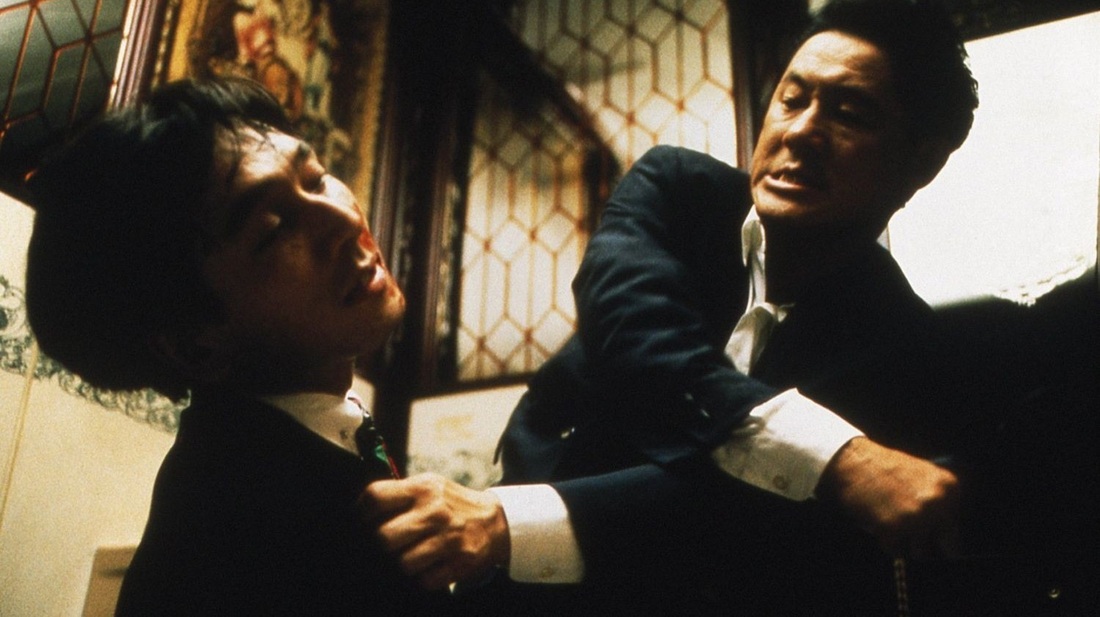|
How entertaining? ★★★★★
Thought provoking? ★★★☆☆ 16 December 2007
This a movie review of SONATINE. |
“Not fair! You are using a real gun!” Ken (Susumu Terajima)
1993 film SONATINE is probably director-actor-writer-editor-producer ‘Beat’ Takeshi Kitano’s best. Here he set in stone the template for most of his films as director: surreal, ‘Beat’ playing a taciturn yakuza embroiled in violence, serene beauty, meditative, sudden bursts of violence, witty humour often of the dark variety, and reaction shots to threats, death and jokes. SONATINE also has the most beautiful score of all his films, by Joe Hisaishi, who has scored each of Hayao Miyazaki’s Studio Ghibli films.
Opening on an image of a blue fish skewered in front of a red background, with Hisaishi’s theme playing, sets the tone for an imaginative, dreamlike, violent picture. Kitano is Murakawa, a high level yakuza in Tokyo in charge of a lucrative territory. His lack of mercy is demonstrated on a business associate who refuses to pay him; drowning him using a construction crane. Murakawa’s avaricious boss wants his territory for himself, so has Murakawa and his men sent to Okinawa to settle a dispute between a relative’s gang (Nakanatsu) and the Anan clan. Troops are needed to help. Interesting use of the word “troops”, as war is a strong theme – with a fragile peace internally and between gangs, many lives are at stake. Murakawa is tired of the gangster life, and even though he and his lieutenant Katagiri feel something is suspiciously awry they agree to go.
1993 film SONATINE is probably director-actor-writer-editor-producer ‘Beat’ Takeshi Kitano’s best. Here he set in stone the template for most of his films as director: surreal, ‘Beat’ playing a taciturn yakuza embroiled in violence, serene beauty, meditative, sudden bursts of violence, witty humour often of the dark variety, and reaction shots to threats, death and jokes. SONATINE also has the most beautiful score of all his films, by Joe Hisaishi, who has scored each of Hayao Miyazaki’s Studio Ghibli films.
Opening on an image of a blue fish skewered in front of a red background, with Hisaishi’s theme playing, sets the tone for an imaginative, dreamlike, violent picture. Kitano is Murakawa, a high level yakuza in Tokyo in charge of a lucrative territory. His lack of mercy is demonstrated on a business associate who refuses to pay him; drowning him using a construction crane. Murakawa’s avaricious boss wants his territory for himself, so has Murakawa and his men sent to Okinawa to settle a dispute between a relative’s gang (Nakanatsu) and the Anan clan. Troops are needed to help. Interesting use of the word “troops”, as war is a strong theme – with a fragile peace internally and between gangs, many lives are at stake. Murakawa is tired of the gangster life, and even though he and his lieutenant Katagiri feel something is suspiciously awry they agree to go.
|
|
|
Once in Okinawa, Murakawa’s gang get embroiled in a non-existent conflict which escalates into violent hostility involving his gang, Nakamatsu’s group and the Anan clan; all losing men at an alarming rate. Sonatine is one Kitano’s few films to contain an explosion – no fireballs, just grounded in reality like the shoot outs and fist fights that are unexpected and efficient.
Part of the thematic joy is the contradictions in the film: the playful and the violent, surrealism and reality, friendship and betrayal, and peacefulness and conflict. Awaiting orders and hiding out on the beach Murakawa and his men soon relax as though on a holiday, hanging out playing games and tricks on each other. One night Murakawa kills a man attempting to rape a woman, and she becomes drawn to him. She asks the most pertinent question of the film, or of any violent film, if you’re not afraid to kill people are you not afraid to die? Going against typical movie heroics, he answers by saying if he wasn’t scared he would not carry a gun; when you get to a point of being scared all the time then you wish you were dead.
The striking visual poetry of SONATINE maybe likened to the oeuvre of Terrence Malick and THE ASSASSINATION OF JESSSE JAMES BY THE COWARD ROBERT FORD, but the style is his own. The imagery is fantastic, from a firework fight and sped up sumo wrestling to a gripping lift confrontation and the tragically sad moment of a henchman dying quietly by just dropping his head. Kitano delivers superb composition and choreography, just look at a tracking shot of a car being followed by the camera through a restaurant, with credit due also to Katsumi Yanagishima (cinematographer) and Hitoshi Takaya (lighting).
As Akira Kurosawa is to chronicling the samurai, Takeshi Kitano is to chronicling the yakuza. Is there a higher analogue than that?







